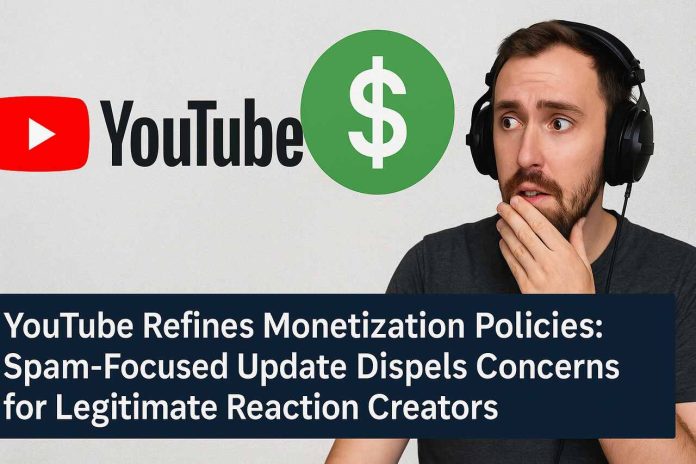Why Did YouTube Update Its Monetization Policy in July 2025?
YouTube updated its monetization policy to combat low-quality spam content while preserving monetization opportunities for transformative and original creators, including those in the reaction video genre. The policy revision targets mass-reuploaded, non-transformative compilations and AI-generated spam, which have degraded viewer experience and advertiser trust.
What Kind of Spam Content Is Being Targeted?
Spam content refers to repetitive, scraped, or low-effort videos that lack originality or transformative value. These include:
-
Content farms that reupload trending clips without commentary or creative editing.
-
AI-voiceover listicles or auto-generated narratives using stock footage.
-
Looped videos of viral moments meant to exploit recommendation algorithms.
-
Duplicative uploads that mirror existing content without new input or perspective.
These content types violate YouTube’s advertiser-friendly content guidelines, as they fail to deliver contextual value, which directly impacts watch time quality, engagement rates, and brand safety metrics.
Are Reaction Channels Affected by the New Policy?
No, legitimate reaction channels remain eligible for monetization as long as they add original commentary, emotional insight, or critical interpretation. Reaction content that demonstrates:
-
Visual overlaying or split-screen interaction
-
Contextual storytelling or opinion integration
-
Personal anecdotes and emotional response
-
Comparative analysis or educational framing will continue to qualify under the YouTube Partner Program (YPP). The key metric is “transformative value”, which ensures compliance with fair use doctrine and creative reuse policies.
What Triggers a Monetization Denial Under the New Guidelines?
Monetization is denied when videos fall under non-transformative reuse, which includes:
-
Reacting silently with no added commentary.
-
Using auto-generated commentary or subtitles only.
-
Playing copyrighted material in full with minor pauses.
-
Uploading a sequence of reaction clips from different users with no cohesive narrative.
These practices violate YouTube’s reuse policy, emphasizing the importance of creative intent, editorial involvement, and viewer enrichment.
How Is YouTube Distinguishing Between Spam and Transformative Content?
YouTube uses machine learning classifiers, semantic similarity scoring, and manual human review to analyze:
-
Narrative originality through speech and audio fingerprinting.
-
Visual transformation using video frame alteration detection.
-
Engagement pattern anomalies, such as click farm behaviors or inorganic view spikes.
-
Channel history signals, like upload frequency, metadata duplication, and viewer retention.
By deploying AI-assisted moderation paired with contextual review, YouTube ensures enforcement does not penalize genre-based creators unfairly.
What Is the Impact of This Update on Content Creators?
How Should New Creators Adjust Their Content Strategy?
New creators should focus on:
-
Integrating commentary and narrative layering.
-
Avoiding full-length copyrighted clips without heavy editing.
-
Developing a unique visual and audio signature for brand identity.
-
Building contextual depth using screen overlays, infographics, or timeline insertions.
YouTube’s system favors semantic density and audience value contribution, not just clip aggregation.
What Metrics Are Used to Assess Monetization Readiness?
The updated system evaluates:
-
Viewer retention and average watch duration.
-
Engagement diversity (likes, comments, shares).
-
Narrative density via NLP models assessing original speech content.
-
Channel consistency and community standards adherence.
YouTube also leverages semantic search indexing, correlating metadata with knowledge graph attributes to judge whether a channel adds new discourse to existing media.
Can Educational and Commentary Channels Still React to Trending Media?
Yes, channels focused on education, pop culture critique, and social commentary remain protected as long as they:
-
Transform content through analytical deconstruction.
-
Offer new insights, cross-references, or media synthesis.
-
Encourage audience discourse by prompting reflective commentary.
The value lies in semantic contribution to public understanding, not just emotional response capture.
What Does This Mean for the Future of YouTube Monetization?
YouTube is redefining monetization standards based on semantic integrity, content authenticity, and viewer benefit. The platform is moving toward:
-
Promoting intellectual and creative merit over replication.
-
Elevating channels that demonstrate contextual knowledge, storytelling craft, and personal brand ethics.
-
Deprioritizing algorithm-gaming behavior and SEO-spam tactics.
By anchoring monetization in content originality and semantic enrichment, YouTube aims to balance creator freedom with ecosystem trust, ensuring long-term sustainability for advertisers and creators alike.
